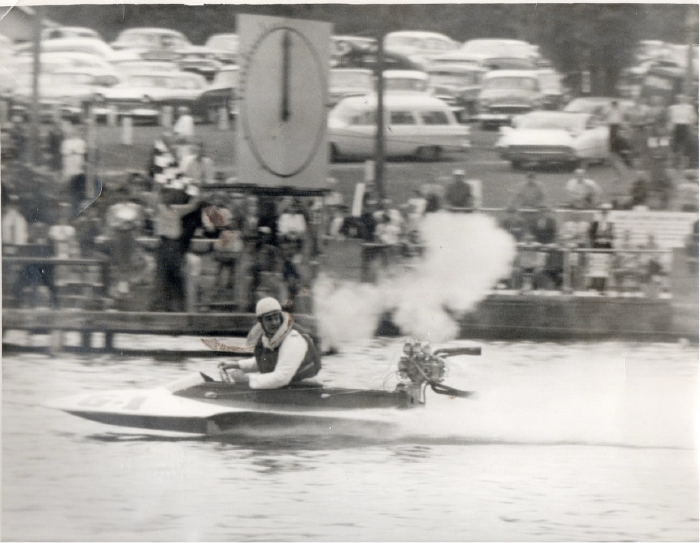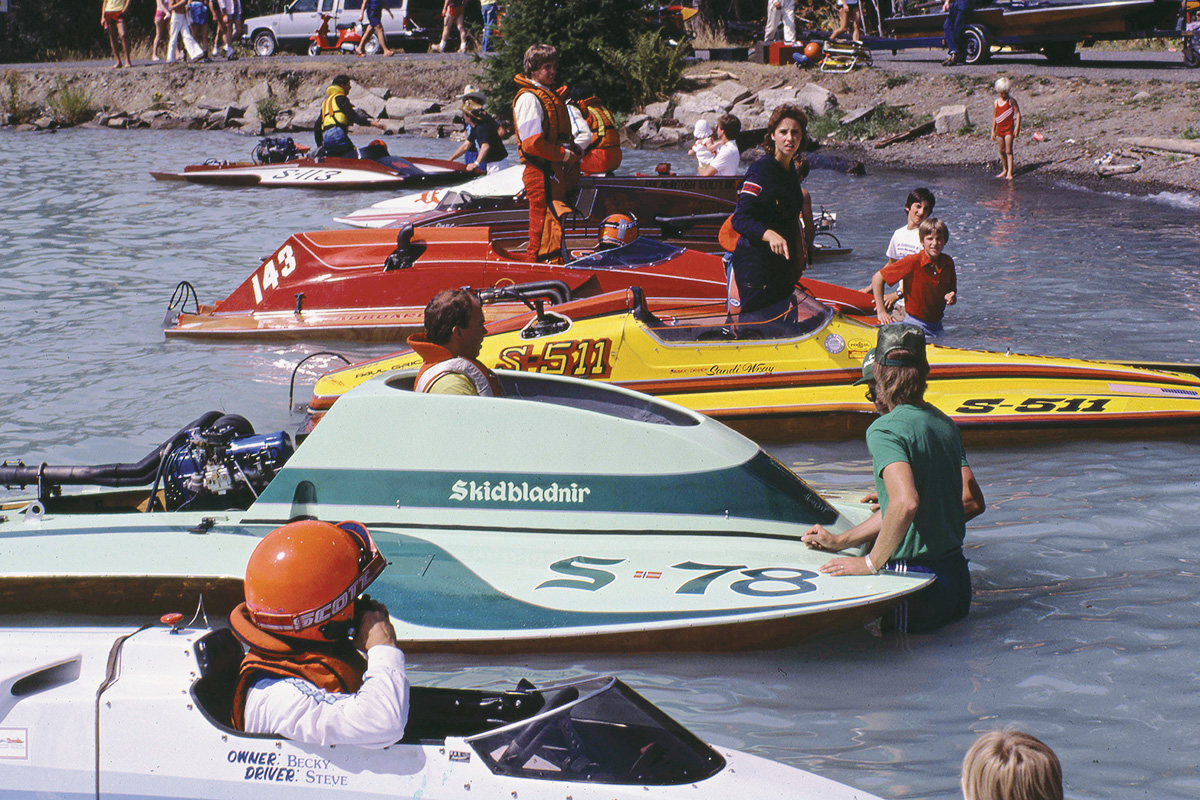A Boatbuilder Shares His Memories
June 28, 2022 - 11:26pm

Ed Karelsen with Greg Jacobsen’s boat. Photo courtesy of Greg Jacobsen
Ed Karelsen was a successful, respected builder of racing boats. His handiwork crossed category lines, from Outboards to Inboards to Unlimiteds. In the following interview, conducted by Craig Fjarlie on January 31, 2012, Karelsen recalls a number of his famous boats and the people he knew.
Maybe you will start by telling us a little about your early life.
I was born in Tacoma, Washington, in 1932, the year Roosevelt was elected. He was a good wartime President, although he wasn’t as good as we thought.
You went to the University of Washington and studied engineering.
I got three years in, almost. The last quarter, I quit. Then I got involved in hydroplane racing when my brother Al bought a D Swift hydroplane.
How did that come about?
Well, we were interested in car racing. I was the youngest of three brothers (Al, then Dave, then me). My oldest brother Al used to go to Aurora Speedway. They had all kinds of racing all the time we were in high school, and we had our own cars and fixed them up. Had a ‘36 Ford, a ‘35 Ford, and I had a ‘37 Chevy. Al kept blowin’ up all the engines. We had three engines in the garage and he’d blow them up every other weekend. I finally told him, “I’ve had it. I’m going to get my own car.” He said, “Blow it up and fix it if you want.”

Jim Benson: Ed Karelsen raced once in the Slough Race in 1956 when Bob Waite won his first of six Sammamish Slough Races. Read my book to find out about Ed’s scary encounters with spectators. Karelsen took 3rd place in the highly competitive B Stock Hydro Class. This was the last race up the Slough for Ed, as he decided building raceboats was safer than driving them. Above, Bob Waite was the “King of the Slough” because he was the overall race winner the most, by far! The photo depicts the 1969 Overall winner, Bob Waite, being kissed by his wife, Mary Ellen (right), and “Miss Seattle Boat Show” at the Kenmore, Washington, Bridge race pits.
Al was the one who went boat racing first?
Yeah, he bought this Swift hydro and a KG-9. Then we met Bob Waite and Bill Farr and we’d go to Lake Sammamish and test it. That was about 1953-54. And then I decided to build one ‘cause I didn’t have enough money to buy one. It was kind of funny- I was going to college with Al’s best friend from Roosevelt High School, Robert Heitz. They were always together. Al had this D Hydro and we were racing it, and Bob and I were going to college and working for Fine Craft Boat Works in Alderwood Manor. The freeway comes through there now. In the early ‘50s there must have been four or five different boat manufacturers building wooden boats. Anyway, my brother started that when he got out of the Navy. I was working for him for a while. Instead of working for him on Friday, Robert and I decided to spend Friday afternoon building a hydroplane. Kind of funny, ‘cause we copied this supposed Swift D Hydro. Another guy got my other brother Dave involved in it. We bought a 10-foot sheet of plywood; and not paying any attention to what we were doing, we laid it all out. It was supposed to be 9-½ feet long. We sawed off the plywood a foot-and-a-half, so it was only 8-½ feet long. (Laughter.) We turned it over and it didn’t look right. It was a 10-foot sheet of plywood, cut a foot-and-a-half off it, and didn’t even pay attention ‘cause we were doing it a couple hours one day a week. We didn’t think about it. That’s the first D Hydro I ever ran. We called it One Foot Short. I took it to wildcat races around here. You know, in the ‘50s, boat racing was real popular and they paid trophies and money. The first race was at Hoquiam on the bay.
Salt water?
Yeah. The tide was out. It was the Fourth of July. I have pictures of us going down, at almost a 45-degree angle. I won the race. The next one was at Raymond. I won there, too. It was better than I expected. We finally joined APBA and went to Pasco for our first race. There were 55 D Hydros. We had two races. Some guys brought D Runabouts. They had 60-some runabouts. I never even got through the eliminations for three years! Those guys were faster than I was. Playing around with those wildcat clubs, that was easy. I was buying props from different guys, and most of ‘em couldn’t know what they were doing.

From Jim Benson: This photo, also on page 279 of my book, Taming of the Slough, was taken in 1956 by Bob Carver at my dad’s boat shop on 8830 Bothell Way in Lake City, Washington State (a Northwest suburb of Seattle). My father, Al Benson, is standing next to my brother, Don, in front of one of the outboard cruisers (Sea Chief line) that Ed helped build along with another boat builder in the mid-1950s at this shop. Karelsen’s boat shop was in an addition on the left side of the building. The garage door to Ed’s shop is open below, between the large Mercury outboard motor sign and the Benson’s lettering. If you look in closely, you’ll see a partially built outboard hydro being fabricated in the opening between the back of our 1954 Ford Station Wagon and the bow of the outboard cruisers.
Ed, how long did you actually drive boats?
I would say eight years at most. I never have run an inboard except at one race- Chuck Hickling’s boat.

Above, John and Ed Karelsen
Jim Benson: Ed Karelsen lost his only child, son John Steven, to a tragic raceboat accident while testing a high-speed outboard hydro on Scooteney Reservoir in Eastern Washington. John died instantly with a neck injury as his boat caught a wake and flipped him out during a slow speed turn back toward the launching area. Dave Culley, former Miss Budweiser unlimited hydro crew chief and good friend of Ed’s, said, “This type of accident could have happened 100 times without incident, but this day was so unfortunate. His dad performed CPR on him when they brought him back to the shore, but to no avail. He was likely transported to a local hospital in the Tri-Cities area near the reservoir, where the soon to be 25-year-old was pronounced dead on May 23, 1983. John was a very likeable young man, like his father, and wanted to follow in his father’s footsteps racing and building raceboats.”
My son’s been around me all his life and wanted to go racing, so I started him racing. His first day, actually (looking at a photo) was in a picklefork I built. Guys were saying pickleforks wouldn’t work on outboards. I said, “Why not?” A guy named Joe Swift built pickleforks (they were called forklifts). And Bill Rankin ran a Swift in the Sammamish Slough when we used to go all the way up. He was so far ahead of everybody when he came out in Lake Sammamish. Real windy. He stuffed it and flipped it at the same time. So, he didn’t think much of it. I never saw one run again until I went to the Alky Nationals in ‘55, maybe ‘56. DeSilva had built one for the B Alky. And this guy won the Nationals going away with it.
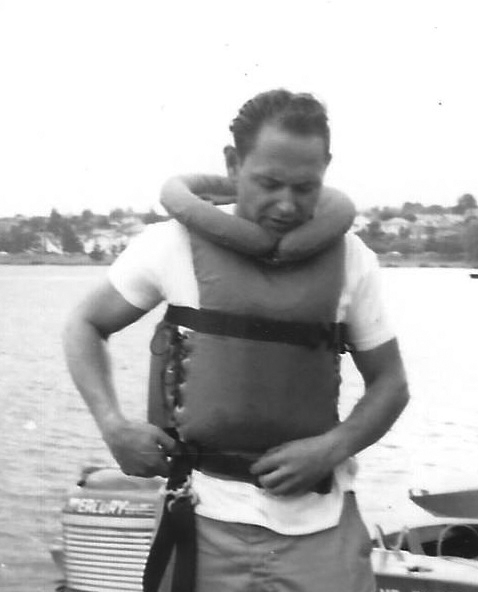 Ed Karelsen in his driving days
Ed Karelsen in his driving days
Jim Benson wrote: This is where Ed built his first JU Runabout (for kid racers between 9 and 15 years old). My dad started building the lightweight runabout for my brother who began racing in the JU Class in 1949 at age ten. Dad had the frames and bottom stringers assembled, which he rounded off all the wood corners to reduce the overall weight. Ed finished it with his fine craftsmanship, but my brother never was able to race it because Mr. Bill Schumacher bought it, as “money talks,” for his son, Billy. Billy eventually broke all our JU Runabout and AU Runabout records driving it.
Back in the ‘50s I was building JU’s. I built one for Billy Schumacher. My JU’s won the Nationals for quite a few years. I built one bigger. I built a C Runabout for Dave Jenkins, but it never worked. Dave was a nice guy but he never had anything that worked. Then I did something different. The other JU’s would only go about 28 miles an hour with the Mercury we had on ‘em. I said, “If we stop the bouncing, they’d go faster.” I bent the keel up so that it couldn’t hit any more. And hell, we won Nationals after Nationals. In fact, Al Lyford asked me if I’d take Chuck Lyford back to the Nationals in Cambridge, Maryland. He’d pay for the whole trip. I was the only guy he knew with a job I could take a month off, and we were gone for about a month. That was Schumacher’s last time we ran it. That was Billy’s last year. A guy back there had all kinds of money, had all kinds of JU’s. He wanted to buy Schumacher’s after he won the Nationals. This guy was going to pay them $2- or $3,000 for the thing. Bill, Sr., says, “No way. I’m going to take it next week to the Canadian Nationals and win that one, too,” which he did do. So, when he was through, I said, “Do you care if I sell the boat?” He says, “No, go ahead.” So I sold him one and he won the Nationals the next two years in a row with that one.

Jim Benson: Billy Schumacher’s famous boat mentioned above. The photo was taken in 1955 at an annual Green Lake outboard race in Seattle, Washington by Bob Carver. It’s also shown in the Sammamish Slough Race on page 279 of my book Taming of the Slough. The Lil’ Bill was originally built as a JU class raceboat. Soon after Mr. Schumacher purchased the raceboat, he brought it back to Karelsen’s shop so Ed could lengthen the hull by about 6 inches. Schumacher Sr. asked Ed to make it legal to race in the AU class, which at that time required a minimum length about 6 inches longer than its original hull length. You’ll see in the photo the white extended portion at the bow, which Ed craftily added to look like it was originally built this way. It was a super lightweight hull deemed legal at all the record race courses. Billy set a number of records and won several national titles in this boat, including the 1955 Nationals at Devils Lake, Oregon and the 1956 Nationals in Cambridge, Maryland, as mentioned above.
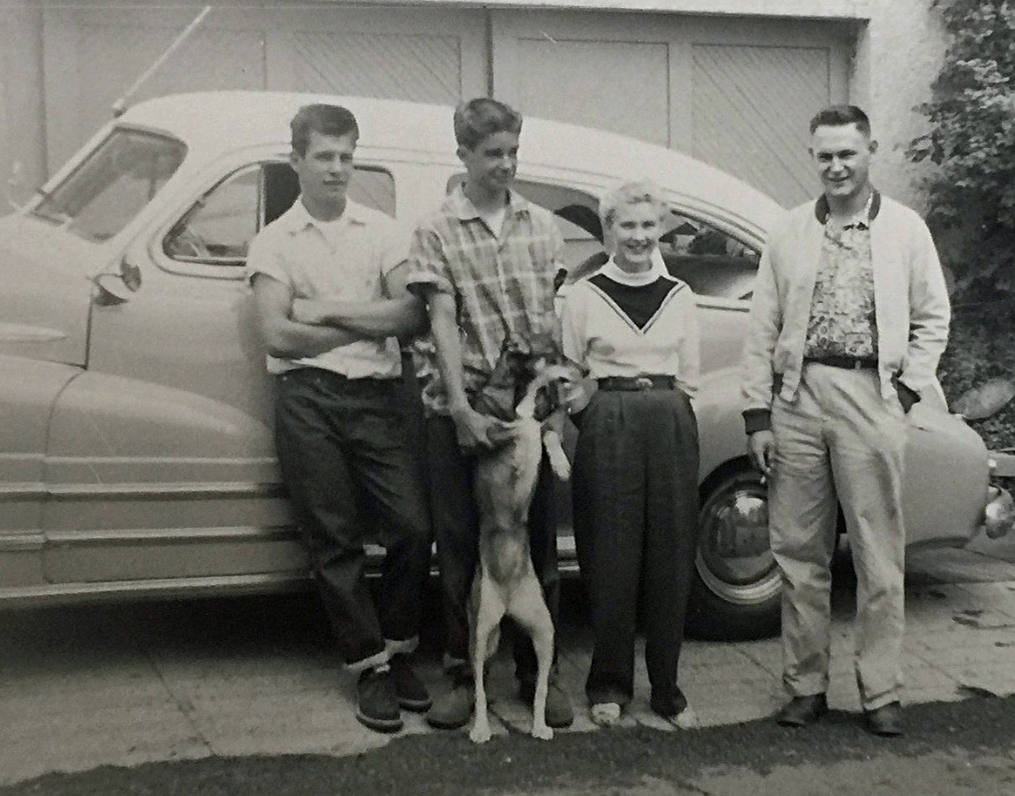
Al Lyford, Chuck and Ginny’s father, hired and paid Ed to drive Chuck clear across the United States from Seattle, Washington, to Cambridge, Maryland, to race in the 1956 Stock Outboard Nationals. That trip was some drive as there were no freeways back then. Father Al provided his powerful and smooth riding 1949 Buick Special to tow Chuck’s raceboats and gear. Ed’s companion was his first wife Ruth, who we all called Ruthie-Chuck took his best friend, Eugene Gross. The Lyford family puppy, Lulu, was in the photo but didn’t travel with them. Photo taken by Ginny Lea Lyford in 1956 just before the group left.
I only built one runabout by myself- a D Runabout off a Hal Kelly design, back in the ‘50s. I was racing it on the river at Wenatchee in rough water. We didn’t have the sides we have now; they were open, and I’m flyin’ all over, both knees bleeding. We ran it up the Slough, just that one season. I say it takes a real man to run a runabout- anybody can run a hydro (laughs). I never was too impressed with those runabouts. The Alky boats, it was stupid to build one because DeSilva had it all locked up anyway, and why compete with him? It makes as much sense as me building tunnel hulls for the series and competing with the Seebolds. He is ahead of me on it, but Seebold wasn’t too interested in these things. The C class, you know it’s 50 cubic inch, three cylinder Evinrude or OMC- a stock class. Being stock and cheap, it was the biggest class in the country. So, I built quite a few of those and sold ‘em all over the country, as good as I could.
Did you and Hugh Entrop work together on some ideas to begin with?
No, we were just good friends. I was with him when he had the big, long boat. For a boat racer, he was the oddest duck you ever met. He’d get sick as a dog. He’d go out in the bushes and vomit before he’d go racing.
My dad paid for the first five years of racing. My brothers and their wives and we’d all go. We’d go to dinner in Oroville and sleep on the beach. One time we were up at Oroville for a weekend, and we were all camping on the beach. I was sitting there talking to Entrop. We had a bottle of Bushmill’s Whiskey, and had quite a bit of it. The rest of us went to dinner. When we came back, Hugh was still sitting in the car. He was so drunk he’s just sitting there. Well, we didn’t disturb him- just let him sleep. I went down to my sleeping bag on the sand. We had an umbrella so the sun wouldn’t be shining in our eyes at 4:00 in the morning. About 6:30 or so I heard this guy moaning and groaning. It was Hugh, on his hands and knees, wanting to stick his head in the water.
That’s the same way a certain photographer was… We called him Cuddles. He would get so drunk out there in his boat his anchor couldn’t catch him. The camera was in the water, swimming to the beach. That night he got arrested in Oroville; they were gonna throw him in jail. Some of the guys went down and got him out. “You got Cuddles here?” You know, things are a little different when you’re drinking. “You mean we got a guy in our jail named Cuddles? Get him out of here.” So, he sat out there with a hangover. Hugh was running this PR that Doc Jones had, with a Mercury lower unit on it, and he wanted to test it. And Hugh said, “I hope it don’t start.” It’s funny – that was the first D Hydro race I ever won. I had used these Oakland-Johnson props for three years. They’d go 64, 65 miles an hour. But we’d come in a long way from first. I had two or three of these steel Kamic wheels. I said, “I can’t win races or nothing, I’m going to try these Kamics.” Well, they only do 58 miles an hour but they do it so damn fast, you’d think it was C Service. I used to keep track of the time because C Services always had the fastest time. They were doing 52 miles an hour and they went around the course faster, ‘cause they were doing it all the way around the course. And so I said, “I’m going to try this.” And I did. In fact, there was a picture on the front of the APBA book for years of the hydros at the start of that Oroville race…
With one guy stuffing?
That’s a kid I went to high school with. Anyway, he didn’t really stuff it. There’s a whole group of guys, and you can see Hugh Entrop. If you look real close at the picture, you’ll see a wake in the picture in front of ‘em all. That was me. High speed is ridiculous, and from that point on I always set my boats up for acceleration. The high speed, I wanted it halfway down the chute, getting ready for the corner. I’d race against Howard Anderson, and Rockey Stone, both fast, all doing 80 miles an hour. My speedometer said 72, and I kept beating them. They’d catch me at the end of the straightway when it was time to turn again. I said, “You’ve got some awfully fast speedometers. I only use those when I want to sell the boat.”
Were you doing your own engine work then, too?
Somewhat. Then I got tangled up with Al Benson. Studying engineering at the University of Washington, your classes were split up real bad, so it wasn’t worth driving out to my brother’s shop in Alderwood. Al Benson was over there on Bothell Way. He’s a great guy and he says, “Put the hydroplanes in the shed on the side here, and you can work on outboard cruisers.” So I stayed with Benson for seven or eight years. I built my hydroplanes and was fixing cruisers and odds and ends.

Above, Ed with his boat trailer
Did you know Ted Jones very well?
I remember Ted Jones when I was building the Exide (Unlimited). He tells all kinds of stories. He says, “You’ve got to have the prop underneath the boat so it’ll prop ride.” And I said, “Well, Ted, you’re pulling yourself up with your bootstraps.” And he says, “No, you gotta have it underneath there because it won’t prop ride.” I said, “Well, I’ve got a boat called Hilton Hy-Per-Lube and the prop’s about six inches behind the boat and it prop rides fine. You got a lot of outboards, the props are all behind it, too.” He was a good guy to go drinkin’ with. I got a kick out of him. As Hugh Entrop told me when I started, I learned how to work with supervision from Ted. He said, “You’ll enjoy all the stories,” because everything that Hugh did, Ted claimed that he did, including all the designs of the boat.

Jim Benson: Karelsen’s first limited inboard build, the Hilton Hy-Per-Lube, which I owned and drove when I worked for Harold Hilton, my employer and sponsor at the time. This was a 150 cubic inch limited inboard class raceboat that was about 18 feet long-an overgrown version of one of Ed’s Class F Outboard Hydros. The engine was a 153 cubic inch Chevy II motor de-stroked to slightly less than 150 cubic inches coupled to a gearbox and V-Drive shaft configuration to move the engine toward the rear similar to a Ski-Raceboat. I purchased the boat at Ed’s suggestion from the original owner who bought it from Ed in about 1962. Ed made some improvements to the hull, and I made some improvements that increased the boat speed from about 85 MPH to 125 MPH. The boat dramatically outperformed all the conventional 150 hydros because it was so fast in the corners-where most of the elapsed time is spent during each lap of racing. The improvements enabled me to set a World’s Record, win the 1967 National Championships and to be inducted into the “Gulf Marine Racing Hall of Fame”. Billy Schumacher was also an inductee as the National Champion Unlimited driver that same year.
Hugh Entrop said in an interview that he used to listen to Jones and take notes, and then he’d put together himself, what he knew would work.
Yeah, it’s the same. I’d known Jones had one out before Hubert drove it. I’d been around boat racing all the time when Hubert Entrop was in it. I think he had one boat previously. The second one, I think, was the best one he built in the 40 cubic inch class. He called it Monkey on a Stick. It was fast, but he was always leaning over the nose of it. It was funny- we always ran 15 boats in a heat then. We used to race a lot in eastern Washington. Harry Woods set up all the races for us. All big trophies and money. I went one year and never took a first place. Four seconds? Hugh Entrop took four firsts; he ran D Hydro in that. I made $800 and I didn’t have a first place. That’s the kind of money they were paying. Now $800 today would be a hell of a lot of money, compared to 1955. I took a B Hydro and got a fourth place, and I picked up a D Hydro and got two seconds. Well, they paid two heats. They gave a first place trophy per heat. So, Hugh ended up with these portable cigarette boxes and gave me one. I gave it to Howard Anderson about five years ago. I said, “You’re still smoking, here’s one we couldn’t win when Hugh won them all.” Anyway, at the races, everything was money. It only cost $2.00 for the entry fee. I remember Lucile Woods (wife of Harry). She’d set up her card table down in the sand with a typewriter on it, and she typed everybody’s entries because they were so sloppily done. She said they’d run like mad, they’d do it and run the whole race. They did that for the four or five years that I was racing. He got good money. He was taking his motel and gas money out of the purse, which he promoted to begin with. He’d go around to all the Mercury dealers. We had a whole series. We raced Wallula, Pasco, Richland, Wenatchee, Oroville, Kelowna, Sand Point and Coeur d’Alene, and down in Oregon. He set all those races up and would offer money and trophies. They always had a big party and free meals Friday and Saturday nights. Boat racing was big then. For years it was that way. Finally, the guys were bitching and Harry quit and went to work for the Pasco committee and set up with all the Unlimited people. He died a few years ago. They did a fabulous job for boat racers. The money you were making was halfway decent. And the farther away you went, the fewer boats you had. We went to Electric City every year. Eastern Washington was fine, but about 1:00 the wind started blowing. One place we raced at Moses Lake it didn’t make any difference. It was narrow and we went north and south. The wind was to the west. But at Electric City on Banks Lake, it was like an ocean. We started running D Hydro. We stuffed eight D Hydros- Swifts. My brother and I sat there and watched Hubert go over all that stuff in that cabover of his and we were awed. Came home and built two of ‘em. The first one was too big, but it worked pretty well. We built the second one and that was a real good boat. In fact, we would just leave the rest of the boats home and take the one boat. I’d put a C on it and run C Stock, we’d put a D on it and my other brother would run D Stock on it. My brother Dave would put a D on it with open stacks, somewhat high performance, but we’d win all kinds of races around here with it. Interesting subject, talking about all that old stuff…
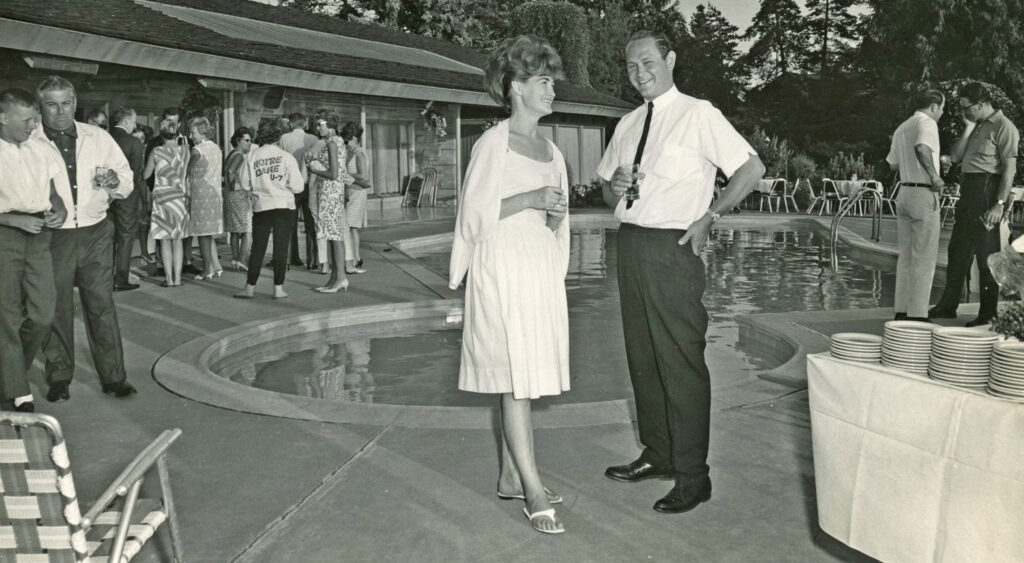
Above, Ed (age 37) and Shirl Karelsen at the Chuck and Mary Lyford residence in the Pikes Peak area near Kirkland, Washington. The 1967 photo was taken, likely, by Bob Carver during a Seattle Seafair Unlimited Race weekend in early August. Lee Schoenith is on far left. Then the back of Mr. Bill Schumacher, Sr., Mrs. Mary Lyford, and Mrs. Bill Schumacher Sr., all talking with young Billy Schumacher. Billy was driving the Karelsen-built Miss Bardahl, which eventually won the 1967 & 1968 Unlimited Hydro National Championships. Ole Bardahl is standing, wearing glasses, behind the lady wearing the Notre Dame U-7 jacket. Shirl and Ed are in the center and Chuck Lyford, likely, talking to Bardahl publicity agent on the right.

The repainted Karelsen National Championship hull, the 1968 U-1 Miss Bardahl. Driver Billy Schumacher is standing on the rear of the hydro.
When you were working with Al Benson, what direction did that take you?
He got tangled up with Unlimiteds through the Stoen brothers, whom I knew. My folks were friends with Glen Stoen from Whidbey Island. He and my dad and cousin were in World War II. I’d known Glen and Milo from Stoen Construction. In fact, they started down here in Greenwood (a district in Seattle) with a rockery business and then a big rock business for roads and stuff. They were interested in boat racing, so they got in that group that bought the Slo-mo V, the Miss Seattle. It was Stoen Construction and Anderson Construction. They were both big road contractors. About 15 guys were involved in that thing, Bill Schumacher and a bunch of them. They were all running out of money. So, the Stoens and Andersons couldn’t pay for all the gadgets, they finally said, “We’re going to make a corporation out of this and you guys either gotta put in your percentage the same as we do or you’re out of it.” So, the guys volunteered to get out because they didn’t have enough money to put into it. They went on racing though. The Miss Seattle ran pretty well, but then they went and bought one from Staudacher all of a sudden.
The Miss Pay ‘n Save.
Yeah, Pay ‘n Save. And it was a Staudacher. It was always on its nose.
And here I was an outboarder, I’m working on this stuff with all these great guys, wanting to be heroes, supposed to know all this stuff. The first thing that happened testing the boat down at Lake Washington, Al Benson was supposed to be the driver. He hit a wake out there and stuffed it. It started hopping and threw his ass up in the air. He came back down, landed on the edge of the seat, and passed out. Boat was still running but finally just went to idle. We got it back and put it on the trailer to take it back to the shop. Al Benson was saying, “My back’s killing me.” So we dropped by the hospital when we left. Well, he had a broken back. He was in a big cast for six months, I think. I was a young pup and they said it was a copy of the Hawaii Kai. We were in Coeur d’Alene and then Chuck Hickling was the driver. In fact, when it went in the air it crimped the deck, so I’d have to screw the deck back down in the center. And Hickling did it once, too. Screw the deck down again. Anyway, I was telling the guys that to me, there was no difference between an outboard and an inboard. If it’s on its nose, you kick it out. Well, it gets to where Mel Hickling (wife of Chuck) told me one day, “These aren’t like the outboards that we carry around on the top of the car; these are different.” I said, “The only difference is they’re bigger and more expensive.” Anyway, Wes Keisling was on the crew and all the top old guys were really good. They knew how to build engines, I will say that much, but they didn’t know anything about boats. We were in Coeur d’Alene and were having trouble with it. Wes Keisling says, “Got a copy of Hawaii Kai.” The Hawaii Kai was sitting there, so I took him to it. So, how’s the depth of the sponsons? Two inches difference. I said, “That’s a pretty big difference; it’s supposed to be a copy.” I could see a quarter inch being off, but not two inches. There’s a picture of it up there (points to photo on the wall). The big splash.
Oh, yeah, it cracked up (as Miss Seattle Too).
Dallas Sartz was driving it. You can see him. He didn’t get killed ‘cause when you stuffed those old ones, it just catapults you out of there. So that was the end of it. I told ‘em, “It had a great big spoiler on it which was saving it when they were stuffing it. It’d pop out again.” And I said, “Look, you guys never changed the thing.” Everybody changed the sponsons and that’s not the trouble, as long as the angle was close to three degrees or five. The nose was stuffing and popping out. In fact, they went and put 500 pounds of lead shot back in the rear. Didn’t make a bit of difference. All it did was break the shot. I mean, we had to put shot throughout the hull until we crashed it. I told them, “We need more air in front of it. Why don’t you reposition the center or the thinner air, to stop it from stuffing. Take two-thirds out of each side and let the air back in.” They didn’t like that idea so they took the whole thing off. That’s a picture of it right after they took the whole thing off. Stuffed it after the starting line and there’s nothing left of that one.

A lightning-quick timed photo by Bob Carver shows Miss Seattle disintegrating on Sunday, August 5, 1962 during the APBA Gold Cup in Seattle, Washington. Airplane pilot Dallas Sartz was the driver and incredibly, he survived, but never to race again. Carver had his eye on this boat, as he knew it was only a matter of time before the sometimes porpoising hydro would take a nosedive. Carver was at Lake Washington on a patrol boat inside the racecourse, alongside the first straightaway, just past the starting line. The race was witnessed by over 100,000 spectators while another 10 million people were attending the local World’s Fair, the “Century 21 Exposition.”
So, then they got the Exide sponsorship. They got Ted Jones to design them a new boat. Ron Jones was supposed to build it but by that time he was too busy. Milo Stoen was in there with Benson and they asked me if I could build it. I said, “Sure.” We only had 58 days to do it and you gotta be in Detroit. I worked day and night with two guys helping me, and we built the thing. The odd part about it, I think it was just a copy of the Thriftway that Ted drew. He came over with a piece of butcher paper, flat, one inch to the foot scale, 30-inch long drawing. And I converted it to a full-size drawing out of plywood. The side view and top view, because that way you can take the frames off as long as there’s another view. See the frames where you want them, turn it sideways, you can measure and you can do it. Anyway, the shaft angle he had I presume was correct. The only thing was, Ted was in Reno making Tahoe Miss too, and I guess Bill Harrah was paying him more money to stay down there than come up and help us. Anyway, he didn’t do the lofting, so they asked me if I’d like to do it. Well, yeah, do the lofting. Copy the thing. In fact, I should have done it half-size. I do that now, half-size, because it’s easier. You can set it on a bench and stand up and read it instead of crawling with all those big plans. And with half-size, you can’t miss it very far. Anyway, I lofted it all off with the shaft angle and everything, and then we were in sort of a hurry so we were machining the hardware and everything as we were building it. The only thing Ted did, when we were ready to turn it over, he came and drilled the prop shaft for the TV staffers. It was just B.S. Ted was a lot of fun. I don’t think he knew too much about hydroplanes, but he was a helluva lot of fun.
Anyway, where were we? I don’t know what happened with that shaft angle. He missed the hole. They had it too steep. The hardware wouldn’t fit. I said, “Can I check everything, check the hole against the plans?” Well, of course. They called up Ted about it. I said, “I can always drill the hole again, waiting for the floorboards, and the shaft log will cover it, the hold, anyway. It’ll be no big deal once you provide it.” He says, “No, no, no. I’ve changed it, I want it that way.” Well, okay. The first time we ran it, it was on its nose. We were sitting out there just testing it, on Lake Washington at Sand Point. They went to Detroit, and I guess the only boat that was worse than it was the Tahoe Miss that he just designed, too. And so they took the boat to Staudacher’s to see if they could figure out what to do. Ted was so mad about that he told ‘em he was going to sue them if they went up to Staudacher’s to see his new design. So they brought it home and had me shim the sponsons a couple times, which I knew wouldn’t help. I didn’t know anything about inboards at that time. I knew when Ted built the first one it had a three degree shaft angle. These other things had eight or nine degrees. So, anyway, they couldn’t figure out what to do with it. The last race we took it to was Coeur d’Alene; Mira Slovak was the driver. They had some good engines. They had power, never bent a quill shaft. Put all the money into quill shaft designs. They were fast. Anyway, Bill Muncey blew past Mira and Mira couldn’t stand it, so he put his foot in it. He stuffed that one really good. There wasn’t anything left. They got three different sheet sections for the bottom, and the only one that was left was the rear one. The whole bottom was gone, from that forward. One sponson was missing, the other one was just hanging. We strapped it to the trailer and took it out to Stoens’ quarry and ran the bulldozer over it. They took the hardware to the shop and put it away.
Before they did that it was on display, on tilt on the trailer, at Seafair.
I had some pictures of that around here somewhere. In fact, we took the sponson that was separate and auctioned it off at the annual outboard party. Harold Tolford’s mother won it. She put it in her front yard and filled it with dirt and made a planter out of it. (Laughter.) So that’s where that boat ended. So then they bought the Wahoo.
Yeah, they needed a boat real fast so they bought the Wahoo.
That was probably the best boat of that series that Ted ever designed. You’ve seen that picture of the Wahoo running. That’s the way you want a boat to be. That’s the result of balance and shaft angle. It’s neat and there’s no difference in setting up an outboard, except there’s a lot more ways to kick ‘em out. Those boats were fantastic. The only reason they wiped it out, the Notre Dame wasn’t working that well and Rex Manchester was going by him at Washington, D.C., when he blew over and Don Wilson ran into him and they both got killed. (At that time, the Stoens had sold the boat to Bernie Little, who was campaigning it as Miss Budweiser – Ed.) And that’s when Bardahl had the cabover.
Yes, Ron Musson drove it.
Yeah, Ronnie Musson. They had pictures overhead in the shop. He’s sitting in the cockpit going (gasps), five or six pictures, he was afraid it was going to stuff. And that’s what it did.
Yeah, it did.
Quite a few of those boats that Jones built stuffed. I don’t know what was wrong, never had a chance to see one close. They might know about ‘em now. That’s the first thing I would check, the shaft angle. That’s the easiest thing to do but the hardest thing to change on an inboard. The outboards, you can just jack the motor up, and the same thing with these tunnel hulls, just in and out.
Trim.
Height and trim. That’s why I couldn’t figure out why Hickling ever built one. I said, “Well, you don’t know anything about tunnel hulls. You can’t trim it going in and out of corners.” That was always the difference in the thing. Well, the inboards, you can’t do that.
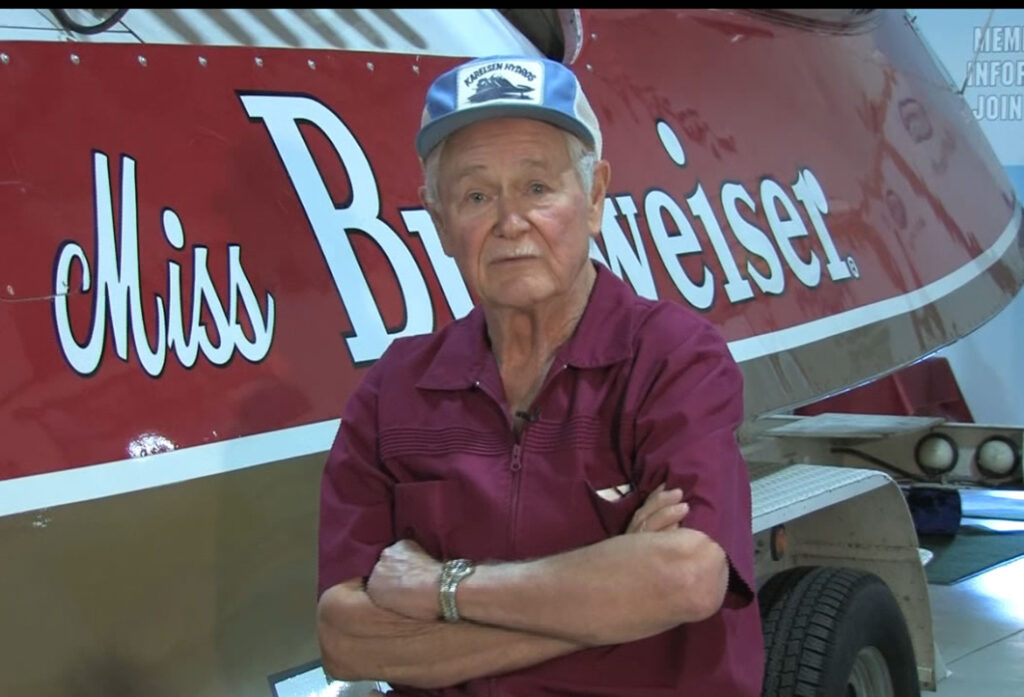
Unlimiteds too: Ed with Miss Budweiser
To back up for a moment, you said you did drive an inboard once?
I tried to run one once. Hickling had a 145 and I took it for a ride, first one I’d ever been in. I went roaring off across Lake Washington and I went to turn it, and it wouldn’t turn. I said let’s go back to Kenmore, the marina there. “How do you turn this thing?” He said, “Well, you gotta flip it. You gotta hook it going into the turn.” I said, “You gotta hook it? That doesn’t make sense. I’m used to the outboards, you just turn the wheel.” And so, then I found out, you want to drive one of them conventional boats, you have to have big balls! They’re horrible.
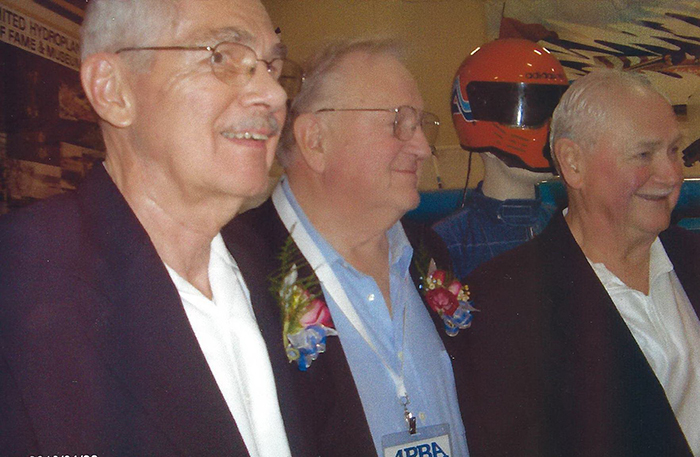
A trio of greats: Ron Jones, Don Kelson, and Ed Karelsen
Below, part of Rusty Rae’s profile of Ed Karelsen in the March 1988 issue of Powerbpat magazine. 
Many thanks to Greg Jacobsen, and David Williams of the Hydroplane and Raceboat Museum, for photos.
– – – – –
This is the end of part one of the interview with Ed Karelsen. Part two will appear next month.
Featured Articles






